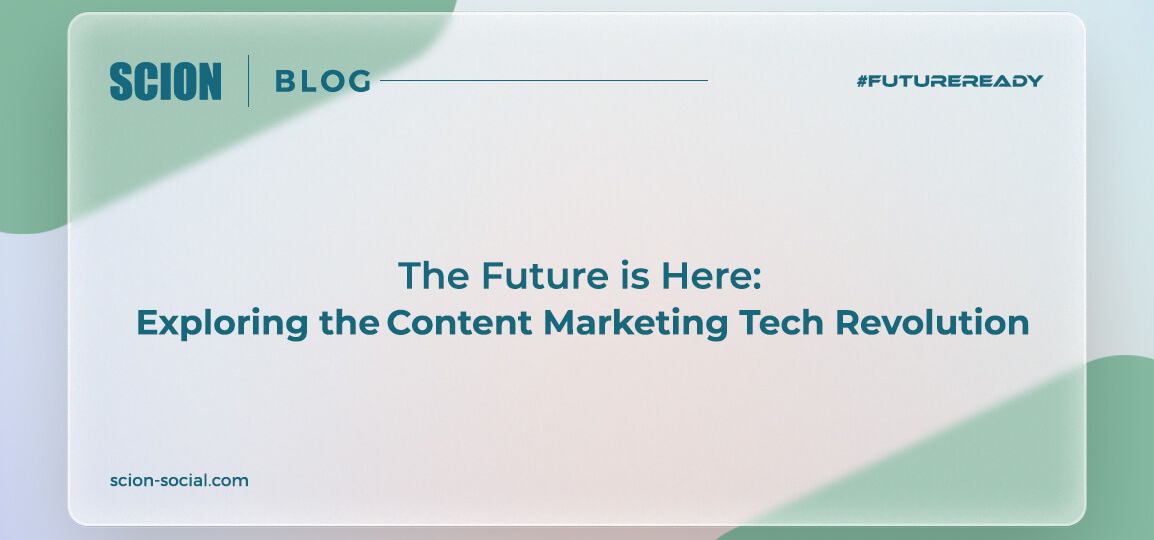
Remember that time you were scrolling through Instagram, and BAM! A picture of a mouthwatering burger pops up. Your stomach growls, and suddenly, you’re craving dinner. Or maybe you saw that perfect pair of shoes you’ve been dreaming of, and you finally make the purchase you’ve been stalling for weeks. Well, That’s content marketing in action!
In today’s digital age, how we consume and create content has completely revolutionized. So, let’s explore the tech trends that are currently transforming the content landscape.
Content Consumption
The past five years have seen a dramatic shift in how we consume content. Short-form video platforms like TikTok, YouTube Shorts and Instagram Reels have revolutionized content consumption, with quick, engaging videos capturing our attention.
Mobile devices have become the primary way we access content, leading to a surge in mobile-optimized websites and apps. Additionally, AI-powered personalization has tailored content recommendations to our individual preferences. To stay relevant, content creators must adapt to these changes by delivering engaging, high-quality content that is optimized for mobile devices and aligns with evolving consumer preferences.
Technology takes the Wheel: From Passive to Interactive
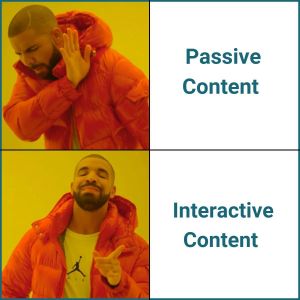
Technology isn’t just changing how we watch cat videos (though it’s definitely made that more efficient). It’s reshaping everything from content formats to distribution channels. Gone are the days of static, one-size-fits-all content. Now, it’s all about creating interactive, personalized experiences that keep audiences hooked.
The Rise of the Snackable, Short-Form Content
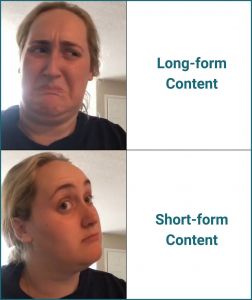
Attention spans are shorter than ever, and content is following suit. Platforms like TikTok, YouTube Shorts and Instagram Reels are booming with short-form video content that’s engaging, digestible, and perfect for on-the-go consumption. This shift means creators need to be laser-focused on delivering value quickly and leaving viewers wanting more.
Major Shifts in Content Creation in the Last 5 Years
Remember when content marketing was just about static social media posts, long-form blog posts and email newsletters? Well, those days are long gone! Over the past five years, the content game has completely changed. Short-form videos, AI-powered tools, and a whole lot more have taken center stage.
Let’s dive into the major technological shifts that have reshaped the way we create and engage with content.
The Power of Visual Content
Let’s face it, visuals are king. Infographics, videos, and eye-catching images capture attention and make information more digestible.
Short-form video dominance
Platforms like TikTok, YouTube Shorts and Instagram Reels have revolutionized content consumption making it easier than ever to create and consume bite-sized, visually appealing content.
Why the shift? It’s simple: short-form videos are highly engaging, easy to digest, and perfect for capturing attention spans in our fast-paced digital age.
Live streaming
Real-time interaction with audiences has become increasingly popular, especially on platforms like Twitch, YouTube Live, and Instagram Live.
This allows users to interact and engage with creators in real time
Interactive video
This innovative format allows viewers to make choices within a video, creating a more personalized experience.
There are countless tools out there to help you create stunning visuals. Canva and Adobe Creative Studio are popular choices for a reason – they’re user-friendly and powerful.
But have you heard of AIcoustics? It’s a lesser-known gem that can significantly improve your audio quality. This one is pretty neat- it literally cleans up audio tracks, making them crisp and clear.
Here’s how we’ve used it:
The Process:
The result:
AI: Your Content Creation Sidekick (or Soon-to-be Overlord?)
One of the hot topics in any conversation today- Artificial Intelligence. AI has significantly revolutionized the way we create content, from generating content ideas to writing drafts, and even optimize content for SEO. This means content creators can spend less time on mundane tasks and focus on more strategic aspects of their work.
While AI can’t replace human creativity, it can certainly augment it. Our top picks for content writing tools are Copy.AI and Jasper.AI.
As you can see below, Copy.AI has a list of workflows to help you get started from a blank page.

You can also use the Chat feature to generate specific asks and play around with the use cases to get even better results!
Voice Search Optimization
With the rise of voice assistants like Siri, Alexa, and Google Assistant, people are increasingly using voice to search for information. To optimize content for voice search, content marketers need to focus on natural language and long-tail keywords. For example, instead of “how to increase YouTube views,” we should optimize for phrases like “how can I get more views on my YouTube channel?”
The key is to focus on understanding how people naturally speak and combine it with relevant keywords (like “YouTube” and “views”). That way, we can create content that’s more likely to appear in voice search results.

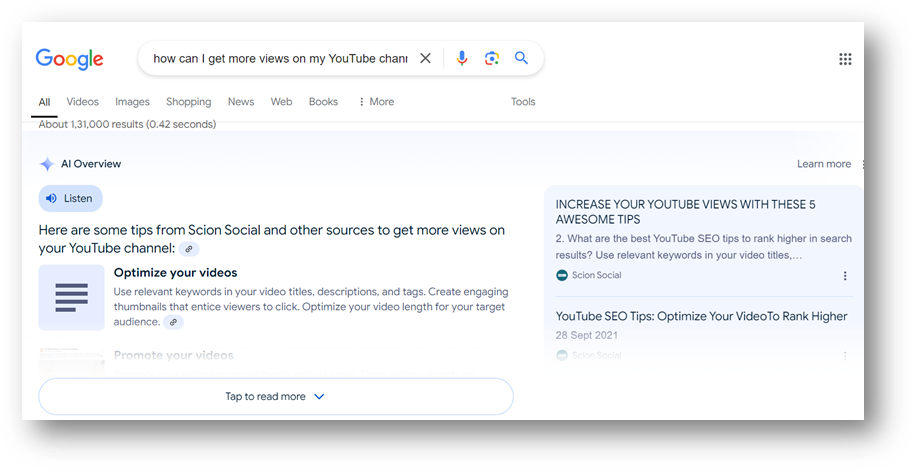
Disclaimer: We may have added some additional keywords in the above image, but you get the gist. And yes, we do have a lot for you to explore. 😉
Personalization: Tailoring Content to Your Audience
In today’s data-driven world, personalization is key. Gone are the days of one-size-fits-all content. Today’s consumers expect personalized experiences. AI-powered personalization tools allow marketers to deliver highly targeted content to individual users.
Tools like Hootsuite and Sprout Social help analyze audience data and target content accordingly.
We’ve been using Hootsuite Analytics to level up our content game for one of our top clients, Dr. Ivan Misner. By diving into the data, we can see what kind of content the audience loves and appreciates more of.
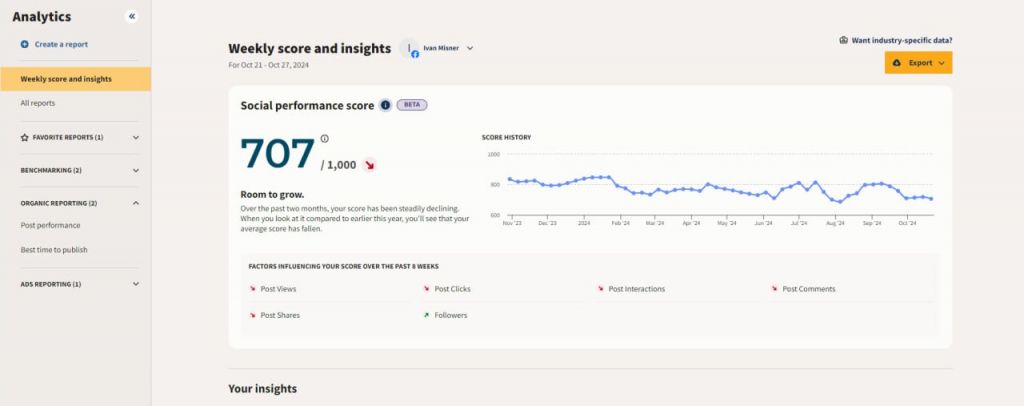
This helps us make smarter decisions about what to create, ensuring that we deliver content that resonates with their audience.
Interactive Content: Engaging Your Audience
Interactive content is a powerful tool for capturing attention and driving engagement. You may have seen formats like quizzes, polls, and calculators that can make content more fun and interactive, encouraging users to spend more time on your website or social media page.
Interactive content can also provide valuable insights into audience preferences and behavior.
How Technology Has Revolutionized Content Distribution
In today’s digital age, creating exceptional content is just the first step. Effectively distributing it to your target audience is equally crucial. Technology has significantly transformed the way we share and consume content, offering innovative tools and strategies to maximize reach and engagement.
Social Media Automation
Social media platforms have become indispensable channels for content distribution. However, managing multiple platforms manually can be time-consuming. Social media automation tools have emerged as powerful solutions to streamline this process. These tools allow you to:
- Schedule posts: Plan and schedule content in advance, ensuring consistent posting across different platforms.
- Engage with followers: Automatically respond to comments, likes, and messages, fostering community engagement.
- Analyze performance: Track key metrics like impressions, clicks, and conversions to optimize your strategy.
Global marketing experts agree that marketing automation is the second most effective digital marketing technique, right after content marketing. Businesses using automation are 20% more productive, and over 61% of marketers rely on it to generate and nurture leads. (CRMSide)
Here’s how we use HootSuite for social media automation:
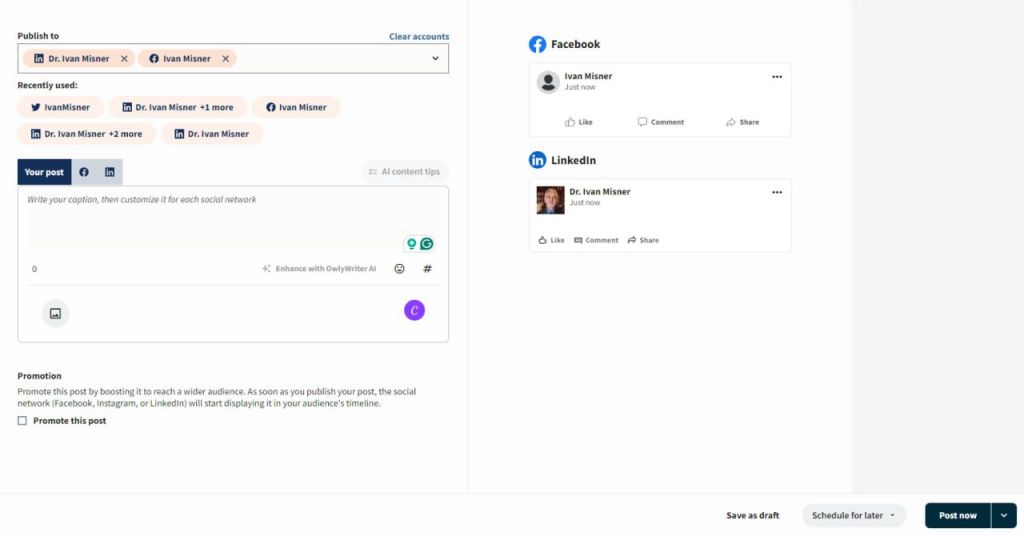
As you can see, this tool allows us to cut down time by scheduling posts on multiple channels.
Content Optimization: SEO for Maximum Visibility
Marketers know that Search engine optimization (SEO) is the art of making content discoverable through search engines like Google. Although SEO updates are ever-changing, one thing remains the same- it is absolutely a crucial aspect of content planning and content creation because over 70% of online experiences always start with a search engine. (Google, 2023).
SEO tools empower you to:
- Do thorough keyword research: Identifying relevant keywords and phrases that your target audience is searching for.
- Build on on-page optimization: Optimizing your content’s title tags, meta descriptions, headings, and body copy to improve search engine rankings.
- Focus on link building: Building high-quality backlinks to your website, boosting its authority and credibility.
Email Marketing Automation: Nurturing Relationships
Email marketing offers a significant return on investment, with an average of $36 for every $1 spent. (DMA, 2023)To date, email marketing remains a highly effective way to connect with your audience. Email marketing automation tools enable you to:
- Create personalized campaigns: Create targeted email campaigns based on user behavior, preferences, and demographics.

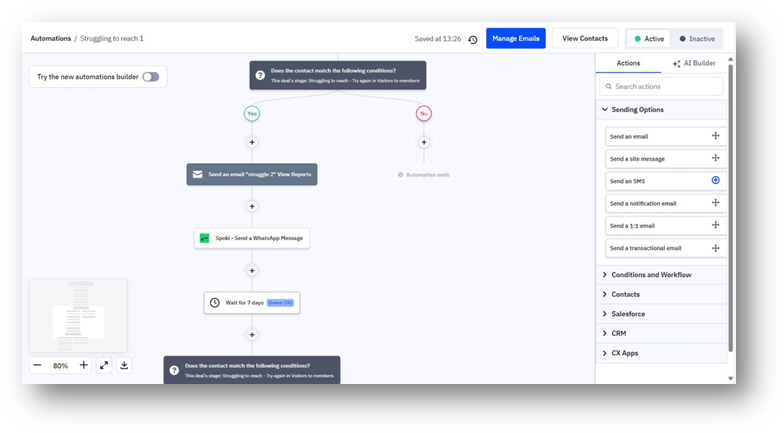
We use a tool called ActiveCampaign that helps us automate both emails and WhatsApp messages.
Emails are handled directly by ActiveCampaign, while WhatsApp messages are automated using a tool called Spoki, which integrates with ActiveCampaign. This is how we segregate our target audience based on the respective categories they fall under.
- Create automated workflows: Set up automated email sequences to nurture leads and convert them into customers.
- Track performance: Monitor key metrics like open rates, click-through rates, and conversion rates to measure the success of your campaigns.
Content creators and marketers can effectively distribute their content, reach a wider audience, and drive meaningful engagement by leveraging these technological advancements.
Remember, while technology is a powerful tool, human connection and genuine interaction remain essential for long-lasting relationships with your audience. A good balance between tech and human connection is key to building strong relationships with your audience.
A Glimpse into the Future of Content Marketing
The landscape of content marketing is constantly evolving, driven by technological advancements. Let’s delve into some of the most promising trends to look out for:
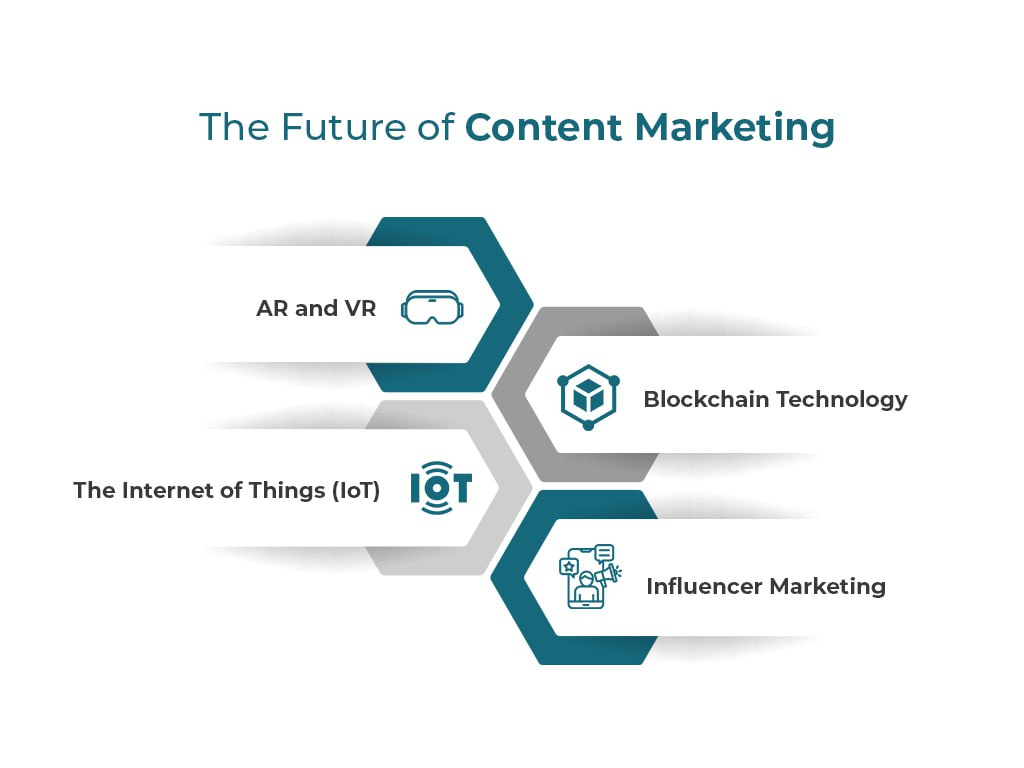
Augmented Reality (AR) and Virtual Reality (VR)
AR and VR are poised to revolutionize the way we experience content by creating immersive digital experiences. With the use of AR and VR, businesses have been able to:
Enhance Product Demonstrations
Which allows customers to visualize products in their own environment, such as trying on clothes virtually or seeing how furniture would look in their living room.
Tell Compelling Stories
Transporting audiences to different worlds and time periods, creating emotionally resonant brand experiences.
Gamify Marketing
Engaging users through interactive games and challenges that reinforce brand messaging.
A recent study by PwC predicts that AR and VR could contribute up to $1.5 trillion to the global economy by 2030.
Blockchain Technology
In simple terms, blockchain technology is like a digital chain of blocks, each block containing information that is secure, transparent, and can’t be changed once a transaction is recorded.
Blockchain technology offers the potential to:
Secure Content Ownership
Ensuring that creators retain ownership of their work and receive fair compensation.
Verify Content Authenticity
Combating the spread of misinformation and fake news by providing a transparent record of content creation and distribution.
Enable Micropayments
Facilitating direct payments between content creators and consumers, potentially empowering independent creators.
While still in its early stages, blockchain has the potential to disrupt the content industry and empower creators.
Internet of Things (IoT)
IoT is about connecting everyday objects to the internet. The increasing number of connected devices opens up new opportunities for content marketing. Think of your smartphone, which is already connected. Now, imagine your fridge, your car, or even your light bulbs being connected too. These devices can then communicate with each other and with the internet, allowing for automation, remote control, and data collection.
A simple example can be when your fridge could automatically reorder milk when it’s running low. Pretty cool, right?
IoT-powered content can:
Personalize Experiences
Delivering tailored content based on individual preferences and behaviors.
Create Interactive Content
Develop content that responds to real-world stimuli, such as voice commands or sensor data.
Enable Location-Based Marketing
Deliver relevant content to users based on their physical location. This is one step ahead of Geofencing.
As IoT continues to expand, marketers can leverage these technologies to create more engaging and personalized content experiences.
Influencer Marketing
Influencer marketing has evolved beyond traditional celebrity endorsements. Micro-influencers, with their smaller but highly engaged audiences, are becoming increasingly popular- you see this in almost all the social media platforms you’re on. Influencer marketing enables you to:
Build Trust and Authenticity
Connecting with audiences on a more personal level, leading to greater brand loyalty.
Target Niche Audiences
Reach specific demographics and interests more effectively.
Generate User-Generated Content
Encourage followers to create and share brand-related content, amplifying reach and engagement.
According to a study by Influencer Marketing Hub, 93% of marketers believe influencer marketing is effective. As the influencer landscape continues to evolve, brands will need to adapt their strategies to stay ahead of the curve.
A Word on Ethics in the Age of AI
While technology is undoubtedly a powerful tool, it’s crucial to use it responsibly. Let’s dive into some ethical considerations when working with AI and new content creation trends:
AI-Generated Content: A Human Touch is Essential
AI is a powerful tool, but it’s not perfect. While it can generate content, it often misses the mark on nuance and understanding. That’s why human oversight is crucial. Humans can fact-check AI-generated content to ensure accuracy and prevent the spread of misinformation. Plus, we eed to mitigate biases in AI algorithms, promoting fairness and equity.
Let’s not forget creativity! AI might generate content, but it often lacks the spark and originality of human writers. Human input can add a unique perspective and fuel innovation.
Data Privacy: A Fundamental Right
As AI becomes increasingly integrated into our daily lives, protecting user data privacy is more important than ever. Companies should be transparent about how they collect, store, and use user data. Users should also have the right to know how their data will be used and the option to opt out.
To ensure data security, robust measures must be implemented to protect user information from breaches and unauthorized access.
Algorithmic Bias: A Growing Concern
Algorithms power much of our digital world, from search results to social media feeds. But these algorithms can sometimes be biased, treating certain users unfairly based on factors like race or gender. To combat this, regular audits and testing can help identify and address these biases.
Let’s all harness the power of AI to create a more equitable future for all by being mindful of these ethical considerations.
The Final Bite: Stay Tuned for More!
Remember that mouthwatering burger pic that made your stomach rumble? Or those perfect shoes that you just had to have? Well, now you know the real power of compelling content (and how it works)!
Stay tuned for our next blog post, where we’ll delve deeper into the latest tech trends and successful brand case studies to show you how the use technology can help you achieve your unique and specific marketing goals.
See you in the next one!
FAQs
The future of AI in content creation is bright and promising. AI is rapidly evolving, and we can expect to see increasingly sophisticated tools that can assist with everything from idea generation to content distribution. While AI won’t replace human creativity entirely, it will undoubtedly become an indispensable tool for content creators.
Absolutely! AI-powered tools can significantly streamline your content creation process. You can use AI to generate ideas, write drafts, optimize content for SEO, and even create stunning visuals. However, it’s important to use AI as a tool to enhance your creativity, not as a replacement for human ingenuity.
Yes, Google accepts AI-generated content, but it must be high-quality and provide value to users. The key is to use AI as a tool to assist in the creation process, rather than relying on it to generate content without human oversight. Ensure that your AI-generated content is informative, engaging, and original.
No, SEO doesn’t penalize AI content. However, Google’s algorithm prioritizes high-quality, original content that provides value to users. So, while you can use AI to assist in content creation, it’s crucial to maintain a human touch and ensure that your content is informative, engaging, and well-written.
